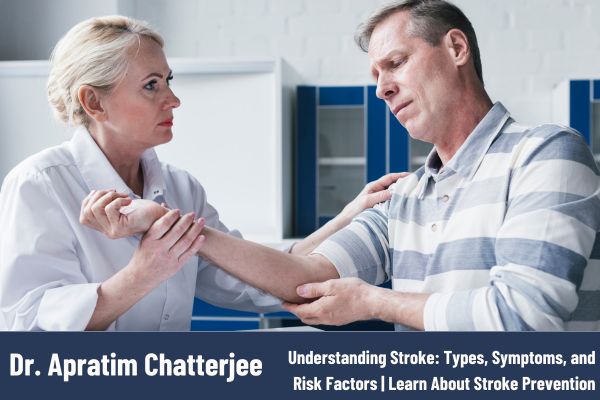Understanding Stroke: Types, Symptoms, and Risk Factors with Dr. Apratim Chatterjee
Stroke is a leading cause of disability and death worldwide, but with the right knowledge and early intervention, its impact can be minimized. In this blog, we explore the various types of stroke, their symptoms, risk factors, and effective prevention strategies, with insights from Dr. Apratim Chatterjee, an expert in stroke management.
Types of Stroke
There are primarily three types of stroke, each of which differs in cause and symptoms. Understanding these types is critical for effective treatment and recovery:
- Ischemic Stroke:
The most common type of stroke, ischemic stroke occurs when a blood clot or plaque blocks a blood vessel in the brain, restricting blood flow. This type of stroke accounts for around 87% of all strokes. - Hemorrhagic Stroke:
This occurs when a blood vessel in the brain ruptures, leading to internal bleeding. It can result from conditions like high blood pressure or an aneurysm. Hemorrhagic strokes tend to have more severe consequences and require immediate medical intervention. - Transient Ischemic Attack (TIA):
Known as a “mini-stroke,” a TIA is a temporary disruption of blood flow to the brain, causing stroke-like symptoms that resolve within minutes or hours. Though it doesn’t cause permanent damage, it serves as a warning sign for a potential future stroke.
Symptoms of Stroke
Recognizing the symptoms of a stroke is vital, as prompt treatment can reduce the severity of its effects. Dr. Apratim Chatterjee emphasizes the FAST method for quick recognition:
- F – Face drooping: One side of the face may droop or feel numb. Ask the person to smile to see if one side is uneven.
- A – Arm weakness: One arm may become weak or numb. Ask the person to raise both arms to check for weakness.
- S – Speech difficulty: Speech may become slurred, or the person may have trouble speaking. Ask them to repeat a simple sentence.
- T – Time to call for help: If you notice any of these signs, seek emergency medical help immediately.
Additional symptoms include vision problems, sudden confusion, dizziness, and severe headache.
Risk Factors for Stroke
Several risk factors contribute to the likelihood of having a stroke. Dr. Apratim Chatterjee explains that while some risk factors cannot be controlled, many can be managed or mitigated:
- High Blood Pressure (Hypertension):
The most significant risk factor for stroke. Chronic high blood pressure can cause the blood vessels to become damaged, leading to the potential for clots or ruptures. - Heart Disease:
Conditions such as atrial fibrillation (an irregular heartbeat) increase the risk of stroke by promoting the formation of blood clots that can travel to the brain. - Diabetes:
Diabetes can cause damage to blood vessels, making them more prone to blockage and rupture. - High Cholesterol:
Elevated cholesterol levels can lead to fatty deposits in the arteries, narrowing the vessels and increasing the risk of ischemic stroke. - Lifestyle Factors:
Smoking, obesity, and lack of physical activity can significantly increase the risk of stroke by contributing to high blood pressure, diabetes, and heart disease. - Age and Family History:
Stroke risk increases with age, and having a family history of stroke or heart disease can also heighten the likelihood of experiencing a stroke. - Excessive Alcohol Consumption:
Drinking too much alcohol can raise blood pressure and contribute to other health conditions that increase stroke risk.
Preventing Stroke: What You Can Do
Understanding the risks is the first step, but prevention is equally important. Dr. Apratim Chatterjee advises adopting a healthy lifestyle to reduce stroke risk:
- Monitor Your Blood Pressure: Keep your blood pressure under control with medication and lifestyle changes.
- Eat a Healthy Diet: Focus on a diet rich in fruits, vegetables, whole grains, and lean proteins while limiting salt, processed foods, and sugars.
- Stay Physically Active: Regular exercise can help control weight, lower blood pressure, and reduce stroke risk.
- Quit Smoking: If you smoke, quitting is one of the most effective ways to reduce stroke risk.
- Limit Alcohol Intake: Drink in moderation to prevent high blood pressure and other health complications.
- Manage Chronic Conditions: Effectively manage conditions like diabetes, high cholesterol, and heart disease with the help of your healthcare provider.
Conclusion
A stroke can be life-threatening, but with a clear understanding of its types, symptoms, and risk factors, you can take action to prevent it. Dr. Apratim Chatterjee encourages everyone to maintain a healthy lifestyle, regularly check their health, and be aware of the warning signs. Early recognition and medical intervention are key to improving outcomes for stroke patients.

